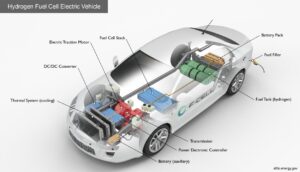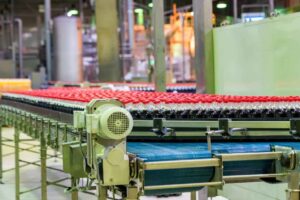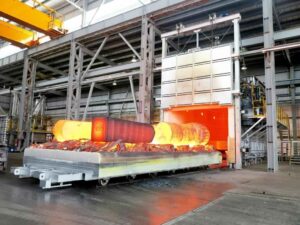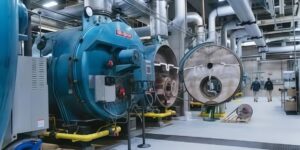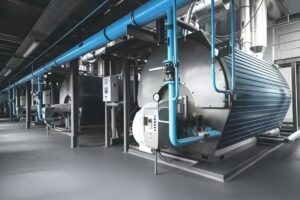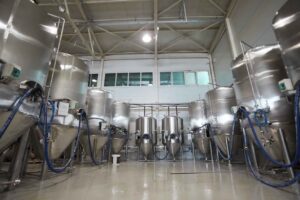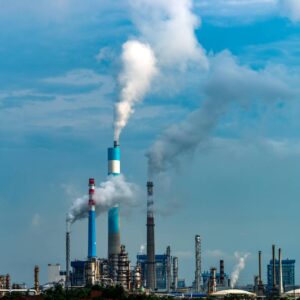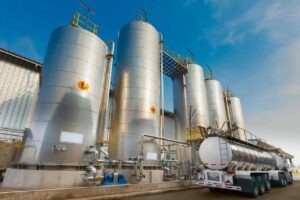Traditional gas analysis methods often struggle with slow response times, limited accuracy, and intensive maintenance. In high-demand industries, these shortcomings can lead to significant safety risks and operational inefficiencies. Laser gas analyzers are rapidly emerging as a superior alternative, offering fast, precise, and contactless monitoring solutions.
Laser gas analysis uses spectroscopic techniques, particularly Tunable Diode Laser Absorption Spectroscopy (TDLAS), to detect gas concentrations with high sensitivity and speed. This non-invasive method is widely used in sectors such as energy, petrochemicals, metallurgy, and environmental monitoring.
While the core concept may seem straightforward, the true value of laser gas analysis lies in the details of its principle, practical applications, and adaptability to complex environments. Let’s break down how it works and why it’s so effective.
What Is the Working Principle Behind Laser Gas Analysis?
Still relying on slow, contact-based gas detection methods?
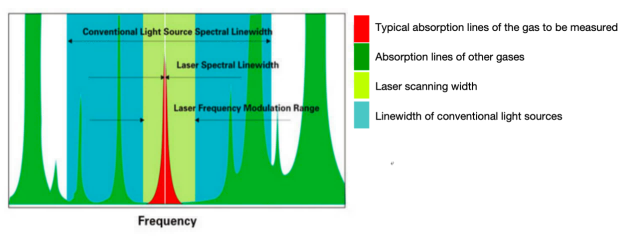
At the heart of laser gas analysis lies Tunable Diode Laser Absorption Spectroscopy (TDLAS)—a highly sensitive and selective spectroscopic technique. It leverages the unique light absorption characteristics of gas molecules to determine concentration levels in real time. Here’s how the process works:
1. Core Principle: Light-Matter Interaction
Every gas molecule absorbs infrared light at specific wavelengths. These wavelengths act like molecular “fingerprints.”
| Element | Description |
| Laser Source | A tunable diode laser emits a narrow-bandwidth infrared beam targeted at a specific gas |
| Gas Sample Path | The laser beam passes through the gas in a transmission cell or in-situ duct |
| Detector | A photodetector on the opposite side measures how much light reaches it |
| Absorption Logic | The amount of light absorbed correlates directly to the gas concentration |
The Beer–Lambert Law governs this interaction:
A = ln(I₀/I) = σ × c × L
Where:
- A = absorbance
- I₀ = incident light intensity
- I = transmitted light intensity
- σ = absorption cross-section
- c = gas concentration
- L = optical path length
2. Tunability & Selectivity
One of the greatest advantages of TDLAS is wavelength tunability. This allows the analyzer to “scan” across the absorption spectrum of a target gas, isolating the exact wavelength where absorption is strongest—eliminating cross-interference from other gases or particles.
For example, when measuring ammonia (NH₃), the laser can be tuned to ~1.53 µm, where NH₃ shows a distinct absorption line—ensuring accurate results even in complex gas mixtures.
3. Configuration Types
Depending on the application, laser gas analyzers can be deployed in multiple configurations:
| Configuration | Description | Typical Use |
| In-situ | Laser and detector mounted across process duct | Flue gas, combustion chambers |
| Extractive | Gas drawn into an analysis cell outside process | Lab settings, sensitive calibration |
| Open path | Laser projected across open-air path | Fence-line monitoring, large-area leaks |
4. Real-Time Feedback
Unlike traditional methods that rely on periodic sampling and offline lab analysis, TDLAS provides continuous, sub-second updates. This real-time data is crucial for:
- Closed-loop process control
- Safety interlocks
- Emission compliance reporting

5. Advantages at a Glance
| Feature | Traditional Methods | Laser Gas Analysis |
| Response Time | Minutes | < 1 second |
| Contact with Sample | Required | Non-contact |
| Calibration | Frequent | Rare |
| Multi-Gas Selectivity | Limited | High (via dual-beam/multiplexing) |
| Maintenance Needs | High | Low |
| Interference Sensitivity | High | Minimal |
Laser gas analysis isn’t just a measurement tool—it’s an enabler of smarter industrial automation, especially in sectors where precision and safety are critical.
What Are the Main Industrial Applications of Laser Gas Analyzers?
Tired of juggling safety compliance, emissions control, and process optimization separately?

Laser gas analyzers have become indispensable in industries that require high-speed, high-accuracy gas detection and control. Their unique ability to operate in-situ, with minimal maintenance, makes them ideal for both continuous monitoring and safety-critical systems. Below is a breakdown of their most impactful industrial applications:
1. Power Generation: Emission Control and Combustion Optimization
In thermal power plants, especially coal-fired and biomass plants, laser gas analyzers are used to monitor flue gases like NOx, SO₂, O₂, and CO. This real-time feedback is crucial for:
- SCR/DeNOx Control: Precisely adjusting ammonia injection to reduce NOx emissions
- Combustion Efficiency: Maintaining optimal O₂ levels to maximize fuel utilization
- Compliance Monitoring: Supporting CEMS for regulatory reporting
Benefit: Reduced reagent use, improved combustion efficiency, and easier emissions compliance
2. Petrochemical Industry: Leak Detection and Process Safety
Petrochemical facilities deal with toxic and flammable gases under high pressure. Laser analyzers are used for:
- Flare Gas Monitoring: Tracking CH₄, H₂S, and hydrocarbons in stack emissions
- Leak Detection: Monitoring fence-line areas using open-path laser systems
- Reactor Control: Measuring O₂ or CO to prevent explosive conditions
Benefit: Increased plant safety, reduced environmental risk, and improved process uptime
3. Metallurgy and Steelmaking: Furnace Atmosphere Control
High-temperature processes such as steel smelting or sintering require precise control of the furnace atmosphere. Laser analyzers are used to monitor:
- Oxygen: To prevent oxidation or ensure reducing conditions
- Carbon Monoxide: To monitor combustion completeness and detect leaks
- Ammonia or HCl: In secondary treatment processes
Benefit: Better product quality, enhanced energy efficiency, and safer working environments
4. Cement Production: Kiln Optimization
Cement kilns operate under extremely dusty and high-temperature conditions. Laser gas analyzers are among the few technologies that can withstand this environment while providing:
- Real-Time O₂ Monitoring: For combustion tuning
- CO Monitoring: For safety and burner performance
- NOx/Ammonia Slip Monitoring: For emission control and SCR optimization
Benefit: Reduced energy consumption, fewer shutdowns, and improved emissions control
5. Environmental Monitoring: Regulatory Compliance and Air Quality
Governmental agencies and industrial operators use laser gas analyzers to meet environmental standards:
- CEMS (Continuous Emissions Monitoring Systems)
- Ambient Air Quality Stations (especially with open-path systems)
- Incinerator Emission Checks
Target gases often include: NOx, SO₂, CO, NH₃, HCl, and volatile organic compounds (VOCs)
Benefit: Accurate, long-term compliance with environmental laws, reduced fines, and improved public image
6. Waste Incineration and Flue Gas Treatment
In waste-to-energy plants or hazardous waste incinerators, laser gas analyzers play a key role in:
- Monitoring acid gases like HCl and HF
- Controlling ammonia slip in SCR/SNCR units
- Ensuring safe CO levels before stack release
Benefit: Better pollution control and reliable operation under corrosive conditions
Application Summary Table
| Industry | Application Focus | Target Gases | Key Advantages |
| Power Generation | Emission control, combustion | NOx, O₂, CO, NH₃ | Efficient SCR, fuel optimization |
| Petrochemicals | Safety, emissions | CH₄, H₂S, O₂, CO | Explosion prevention, compliance |
| Metallurgy | Atmosphere control | O₂, CO, HCl | Energy savings, quality improvement |
| Cement | Kiln tuning | O₂, CO, NOx | Kiln stability, emissions reduction |
| Environment | Regulation & AQ | NOx, SO₂, HCl | High accuracy, 24/7 monitoring |
| Waste Incineration | Gas cleanup | HCl, HF, CO | High resilience, continuous reading |
What Scenarios Are Laser Gas Analyzers Best Suited For?
Struggling to monitor gas in high-dust or high-temperature settings?
Laser gas analyzers thrive where other technologies fail—environments that are hot, corrosive, or physically inaccessible.
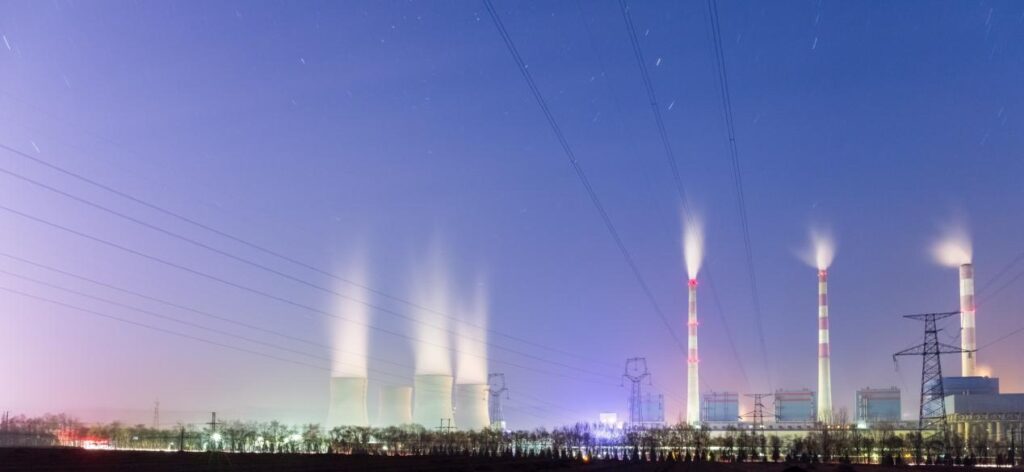
Laser gas analyzers excel in extreme environments where traditional sensors would degrade or fail.Their non-contact design allows them to function in high-temperature zones, such as smokestacks and furnace ducts, without direct exposure. This minimizes maintenance and extends equipment life.
They are also suitable for dusty, corrosive, or pressurized atmospheres, like chemical reactors or desulfurization units. Because the measurement is based on light absorption, the analyzers are not affected by particulates or pressure variations to the same extent as other sensors.
Additionally, laser analyzers are favored for in-situ (on-site) installation, eliminating the need for sample extraction or conditioning—key for operations requiring fast feedback loops.
How Do Laser Gas Analyzers Compare to Traditional Methods?
Still maintaining complex sampling lines and calibration routines?
Laser gas analyzers offer a simpler, smarter, and more efficient alternative to conventional techniques.
Compared to traditional methods such as chemical absorption or non-dispersive infrared (NDIR) analysis, laser gas analyzers offer distinct performance advantages. Their response time is typically under one second, enabling real-time process control, while older systems may take several minutes.
Maintenance requirements are also significantly lower. Traditional analyzers involve sample handling, filtration, and frequent recalibration. In contrast, laser analyzers are often maintenance-free for months or even years, depending on the application.
Moreover, laser technology ensures greater selectivity and linearity, even in multi-component gas streams. There is minimal cross-sensitivity, meaning one gas doesn’t interfere with the reading of another—a common challenge in older systems.
ESE Laser Gas Analyzer
TDL laser gas analysis system ESE-LASER-100 uses the whole process of high temperature combined heat extraction to monitor HCL/HF/NH3 gas in sample gas.The system consists of a sampling unit, a transmission unit, a preprocessing unit, a control unit, and an analysis unit. The analysis unit uses TDLAS technology.

Based on the principle of tunable laser absorption spectroscopy (TDLAS), the laser gas analyzer scans and analyzes the gas absorption spectrum lines of specific wavelengths, and realizes the gas concentration measurement by combining the digital lock-in amplifier and advanced technologies such as a long-path gas chamber. ESE-LASER series can realize high resolution, high precision, stable, and reliable measurement of trace gases, and meet the requirements of process analysis and environmental detection.
Applications
- SCR, incineration & combustion processes
- Emission monitoring: Power generation, engine development, waste incineration furnaces
- Environmental monitoring: Landfill & green-house gases, livestock, …
- Chemical engineering: Production control & monitoring…
- Safety: Leak detection, refrigeration, toxic gases, .
- Climate control & monitoring: Livestock, climate chambers & rooms
Conclusion
Laser gas analyzers represent a major advancement in gas detection technology, combining speed, accuracy, and adaptability. Their suitability for harsh environments and wide-ranging applications make them an indispensable tool for modern industry.






